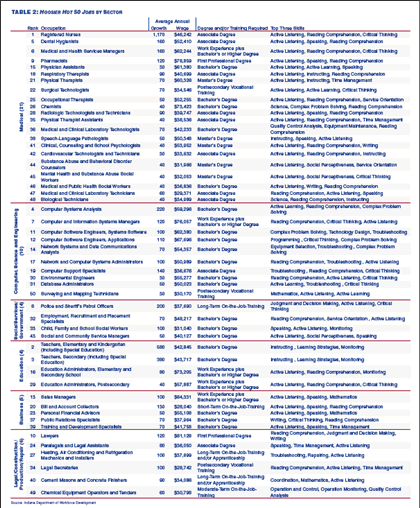Hoosier Hot 50 Jobs
In America, we love winners and the lists that tell us who the winners are. We use lists to choose our movies, music, television shows, stock purchases and where to live. Other lists tell us who is the most beautiful, best-dressed, most popular or has the most money. Our fascination with lists carries over into the area of career planning and guidance. We want to know which occupations offer the most promise for a good job four to six years down the road. We want to know which are the hot jobs.
Frequently, that request results in a list of the fastest-growing occupations in terms of either percentages or straight numeric growth. But those types of lists really have limited value. The “fastest-growing” lists are typically dominated by occupations with small employment, and the “greatest growth” lists are dominated by low-pay, short-hours occupations. For example, the most recent national “fastest growing” list by the Bureau of Labor Statistics (BLS) featured home health aides—a very low-paying job with little training required—as its number one occupation. On the BLS list of largest job growth, number one was retail salespersons—another low-paying, generally low-skill occupation. Some lists are also too short to give a sense of the breadth of occupational opportunities.
Indiana's Department of Workforce Development wanted to provide a genuinely useful list to assist Hoosiers in exploring careers and avoid some of the pitfalls discussed above. We included the three components that one might be most interested in while career planning:
- Fast growth
- A large number of opportunities
- Good pay
We also included the levels of education and training that are common in these jobs.
The result is the first edition of Hoosier Hot 50 Jobs, which can now be seen in employment offices and career centers—as well at the Hoosiers by the Numbers website (www.hoosierdata.in.gov). The list is to be updated every six months.
How Hot Is Hot?
To measure the hotness of a job, three key elements were used: projected job growth (the numeric increase), rate of growth (the percentage increase), and high wages. All selected jobs were required to:
- Be in the top 200 in terms of BOTH total growth and rate of growth in Indiana's 2002–2012 Occupational Projections
- Have wages greater than the statewide median for all occupations according to the latest available Occupational Employment Statistics Survey (OES) for Indiana.
Each of these elements was indexed to give 50 percent weight to the job growth factors and 50 percent to the wage factor in determining the hottest of the hot jobs.
Figure 1 shows the top 10 jobs on the Hoosier Hot 50 Jobs list and their projected growth from 2002 to 2012.
Figure 1: Numeric and Percent Growth of Top Ten Hoosier Hot 50 Jobs, 2002 to 2012

Can I Get a Hot Job Right Out of High School?
The list demonstrates the importance for Hoosiers continuing their education. Table 1 shows the ten highest paying jobs on the Hoosier Hot 50 Jobs list and the corresponding degrees required to obtain those jobs. Of the 50 jobs on the list, 32 require a minimum of a bachelor's degree. Another 13 require at least some post-secondary education.
Table 1: Highest Paying Jobs on the Hoosier Hot 50 Jobs List and the Degree Required to Obtain Them

Do you want to be a bill collector? That's the only occupation on the list requiring only short-term, on-the-job training—and it is the lowest-paying on the list.
Highlights of the Hot List:
Medical fields in general are very hot, containing 21 of the 50 hot jobs (see Table 2).
- Ten hot jobs are found in the computer, science and engineering fields.
- Five are in business.
- Social services/government and education each have four.
- The other six are in legal and construction/production/repair.
Table 2: Hoosier Hot 50 Jobs by Sector
Enhancements for Version 1.2
We are currently exploring other hotness indicators that we can incorporate into our index, including use of short-term (two-year) occupational projections for Indiana (due out this summer), the possibility of some weighting based on a sampled frequency with which the occupation is listed on job-matching websites or use of requisite knowledge, skills and abilities—as opposed to formal training requirements. Hot jobs by region for Indiana's economic growth regions are also under development and should be available this summer. Check our website (www.hoosierdata.in.gov) later this summer for the regional hot jobs and future versions of the Hoosier Hot 50 Jobs listing.
Jon Wright, Research and Analysis Department
Indiana Department
of Workforce Development

